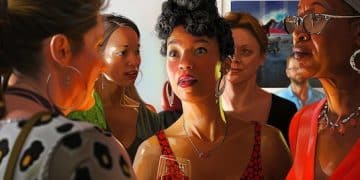The Importance of Diversity in Film: Representation on Screen

The importance of diversity in film lies in its ability to foster inclusivity, challenge stereotypes, drive social change, and enrich storytelling by reflecting a broad spectrum of human experiences.
The world on screen should reflect the world we live in. Exploring the importance of diversity in film: celebrating representation on screen is not just a matter of social responsibility but also an avenue to richer, more compelling stories.
Diversity in film goes beyond simply casting actors from different backgrounds; it encompasses narratives told from various perspectives, stories that challenge societal norms, and a commitment to creating opportunities for underrepresented communities both in front of and behind the camera.
Understanding Diversity in Film
Diversity in film refers to the representation of various identity groups, including race, ethnicity, gender, sexual orientation, disability, and socioeconomic status. A diverse film landscape allows audiences to see themselves reflected on screen, fostering a sense of belonging and validation.
The Definition of Diversity in Film
Diversity in film is not just about ticking boxes or filling quotas; it’s about genuine inclusion and authentic storytelling. It means that diverse characters are not simply tokens, but fully realized individuals with agency, depth, and complexity.
Why Diversity Matters
Representation matters because it shapes our perceptions of the world and ourselves. When certain groups are consistently marginalized or stereotyped in film, it can have a detrimental impact on their self-esteem and their place in society.

By embracing diversity, films can challenge these harmful stereotypes and promote a more inclusive and equitable society. Ultimately, understanding diversity in film and it’s role allows for more informed audience members who can push back against harmful tropes.
- Provides audiences with relatable characters and stories.
- Challenges societal norms and promotes understanding.
- Creates opportunities for underrepresented communities in the film industry.
- Enriches storytelling by bringing new perspectives to the screen.
In conclusion, understanding diversity in film is about recognizing its multifaceted nature and its profound impact on both individuals and society as a whole. This awareness is crucial for fostering a more inclusive and equitable film industry.
The Impact of Representation on Audiences
Representation in film has a powerful impact on audiences, particularly those from underrepresented groups. Seeing characters who share their identities, experiences, and perspectives can be incredibly validating and empowering.
Positive Effects of Seeing Yourself on Screen
When audiences see themselves represented positively on screen, it can boost their self-esteem, inspire them to pursue their dreams, and foster a sense of belonging. This is especially important for young people who are still forming their identities.
The Consequences of Underrepresentation
Conversely, underrepresentation can have negative consequences, reinforcing feelings of invisibility, marginalization, and exclusion. It can also perpetuate harmful stereotypes and limit the aspirations of those who do not see themselves reflected in mainstream media.
When audiences do not see themselves in the media they view on the screen, they can sometimes develop a complex relationship with the content they consume. This is why the importance of diversity in film: celebrating representation on screen must take center stage.

The consequences of underrepresentation are dire and highlight the importance of media that offers viewers and audiences the ability to dream big.
- Reinforces feelings of invisibility and marginalization.
- Perpetuates harmful stereotypes and limits aspirations.
- Contributes to a lack of understanding and empathy between different groups.
- Can lead to feelings of alienation and exclusion from mainstream culture.
In conclusion, the impact of representation on audiences is profound and far-reaching. By embracing diversity in film, we can create a more inclusive and equitable society where everyone feels seen, valued, and empowered.
The Business Case for Diversity
Beyond the social and ethical considerations, there is also a strong business case for diversity in film. Diverse films have been shown to perform better at the box office, attract wider audiences, and generate more revenue.
Diverse Films Perform Better at the Box Office
Studies have shown that films with diverse casts and crews tend to outperform those with predominantly white, male talent. This is likely because diverse films appeal to a broader range of moviegoers, including those from underrepresented communities who are eager to see their stories told.
Attracting Wider Audiences
Diversity in film not only attracts larger audiences but also fosters greater engagement. When audiences see themselves represented on screen, they are more likely to connect with the story, characters, and themes. This can lead to increased word-of-mouth buzz, positive reviews, and repeat viewings.
Attracting wider audiences is good for the box office and that makes studios and movie companies produce quality films with a wide-ranging cast. Diverse stories are what many audience members crave.
- Diverse films attract wider audiences and generate more revenue.
- Diverse films foster greater engagement and emotional connection.
- Diversity enhances creativity and innovation within the film industry.
- Diversity is a key differentiator in a crowded marketplace.
In conclusion, the business case for diversity in film is undeniable. By embracing diversity, studios and filmmakers can not only do good but also do well, reaping both financial and social rewards.
Overcoming Challenges to Diversity
Despite the growing awareness of the importance of diversity in film, there are still significant challenges to overcome. These include systemic biases, lack of access to opportunities, and resistance to change within the industry.
Systemic Biases in the Film Industry
Systemic biases, such as unconscious bias and discrimination, can perpetuate inequality in the film industry, limiting opportunities for underrepresented groups. These biases can affect casting decisions, hiring practices, and the types of stories that get greenlit.
Lack of Access to Opportunities
Underrepresented communities often face barriers to accessing opportunities in the film industry, including lack of funding, mentorship, and networking opportunities. This can make it difficult for aspiring filmmakers, actors, and crew members to get their foot in the door and advance their careers.
Even though the industry is in a constant of change, systemic biased remain and must be addressed so that more diverse groups are able to thrive in movie making. Addressing this importance is paramount to the importance of diversity in film: celebrating representation on screen.
When these biases are eliminated, there will be more of an even plying field in the diverse aspects of Hollywood.
- Address systemic biases through training and awareness programs.
- Increase access to opportunities through scholarships, mentorships, and networking events.
- Challenge stereotypes and promote authentic storytelling.
- Hold the film industry accountable for its diversity efforts.
In conclusion, overcoming challenges to diversity requires a concerted effort from all stakeholders in the film industry. This includes addressing systemic biases, increasing access to opportunities, and challenging stereotypes to create a more inclusive and equitable landscape.
Strategies for Promoting Diversity
Promoting diversity in film requires a multifaceted approach that addresses systemic issues, increases access to opportunities, and fosters a culture of inclusion and equity.
Implementing Inclusive Hiring Practices
Film studios and production companies can implement inclusive hiring practices by actively seeking out talent from underrepresented communities, diversifying their talent pools, and using blind auditions to reduce bias in casting decisions.
Supporting Diverse Storytelling
Supporting diverse storytelling means greenlighting projects that tell stories from various perspectives, challenge societal norms, and feature diverse characters in leading roles.
Supporting diverse storytelling is vital to allowing many individuals and groups have their voices heard on silver screens all over the world. When movie makers can accomplish this, the importance of diversity in film: celebrating representation on screen will never be in question.
- Implement inclusive hiring practices to diversify talent pools.
- Support diverse storytelling and greenlight projects from underrepresented filmmakers.
- Create mentorship and sponsorship programs to support the careers of diverse talent.
- Partner with organizations that promote diversity and inclusion in the film industry.
In conclusion, promoting diversity in film requires a proactive and sustained commitment from all stakeholders. By implementing inclusive hiring practices, supporting diverse storytelling, and creating mentorship programs, we can create a more vibrant and equitable film industry for all.
Examples of Successful Diverse Films
There are many successful examples of diverse films that have resonated with audiences and critics alike, demonstrating the power of representation.
“Black Panther” (2018)
“Black Panther” is a groundbreaking superhero film that features a predominantly black cast and explores themes of identity, culture, and empowerment. It grossed over $1.3 billion worldwide and became a cultural phenomenon.
“Crazy Rich Asians” (2018)
“Crazy Rich Asians” is a romantic comedy that features an all-Asian cast and celebrates Asian culture and traditions. It was a box office hit and sparked a renewed interest in Asian-American stories.
“Black Panther” and “Crazy Rich Asians” showcase the power of diverse casts and the benefit of telling their unique stories. When films such as this are created, the importance of diversity in film: celebrating representation on screen is no longer a question but a fact.
These films pave the way for many more diverse movies being produced for audiences around the world.
- “Black Panther” (2018): Groundbreaking superhero film with a predominantly black cast.
- “Crazy Rich Asians” (2018): Romantic comedy with an all-Asian cast.
- “Moonlight” (2016): Coming-of-age drama that explores themes of identity, sexuality, and race.
- “Coco” (2017): Animated film that celebrates Mexican culture and traditions.
In conclusion, these successful diverse films demonstrate the power of representation and the importance of telling stories from various perspectives. They serve as inspiration for filmmakers and audiences alike, paving the way for a more inclusive and equitable film industry.
| Key Point | Brief Description |
|---|---|
| 🎬 Representation Matters | Seeing diverse characters boosts self-esteem and challenges stereotypes. |
| 🌟 Business Benefits | Diverse films attract wider audiences and perform better at the box office. |
| 🤝 Overcoming Challenges | Address systemic biases and create more opportunities for underrepresented groups. |
| 🌱 Strategies for Growth | Inclusive hiring practices and supporting diverse storytelling will help movies thrive. |
Frequently Asked Questions
What is diversity in film?
▼
Diversity in film refers to the representation of various identity groups, including race, ethnicity, gender, sexual orientation, disability, and socioeconomic status, both on-screen and behind the camera.
Why is diversity in film important?
▼
It allows audiences to see themselves reflected on screen, challenges harmful stereotypes, promotes understanding and empathy, and improves box office numbers for studios and movie companies.
What are some examples of successful diverse films?
▼
“Black Panther,” “Crazy Rich Asians,” “Moonlight,” and “Coco” are all examples of films that have been praised for their diverse casts, inclusive storytelling, and cultural impact.
How can the film industry promote diversity?
▼
By implementing inclusive hiring practices, supporting diverse storytelling, creating mentorship programs, and partnering with organizations that promote diversity and inclusion in the entertainment world.
What are some of the challenges to diversity in film?
▼
Systemic biases, lack of access to opportunities for underrepresented groups, and resistance to change within the industry can all impede progress toward greater diversity and inclusion in movie making.
Conclusion
In conclusion, the importance of diversity in film cannot be overstated. By embracing diversity, we can create a more inclusive and equitable industry that reflects the rich tapestry of human experience. This commitment not only enriches storytelling but also drives social change and empowers underrepresented communities.
Read more content





